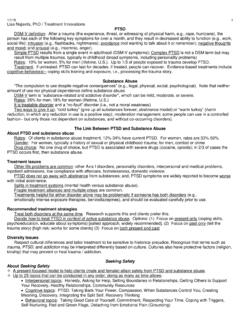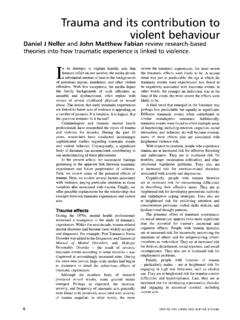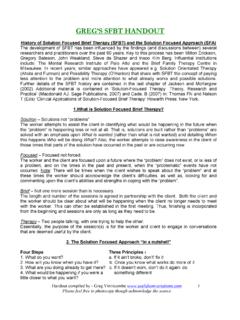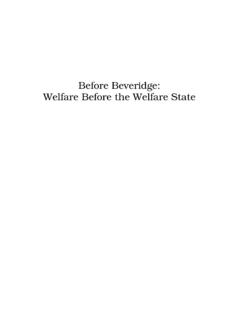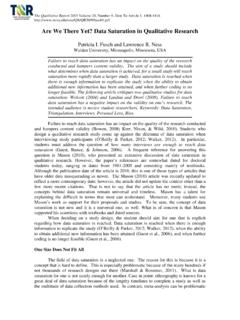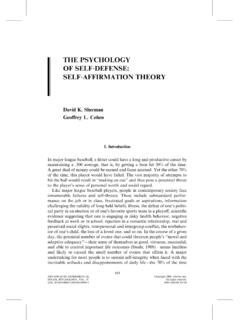Transcription of The Sanctuary Model: Theoretical Framework
1 87 Families in society: the Journal of contemporary social services 2013 alliance for children and Familiesissn: Print 1044-3894; electronic 1945-13502013, 94(2), 87 95 Doi : Sanctuary model : Theoretical Frameworknina esaki, Joseph Benamati, sarah yanosy, Jennifer s. middleton, laura m. Hopson, Victoria l. Hummer, & sandra l. Bloomthis article provides a Theoretical Framework for the Sanctuary model . the Sanctuary model is a trauma-informed organizational change intervention developed by sandra Bloom and colleagues in the early 1980s. Based on the concept of therapeutic communities, the model is designed to facilitate the development of organizational cultures that counteract the wounds suffered by the victims of traumatic experience and extended exposure to adversity.
2 Details of the Sanctuary model logic model are For praCtiCe emerging research suggests the importance of orga-nizational culture in the delivery of evidence-based mental health services and, thus, the need for organiza-tional interventions such as the Sanctuary model . By creating a restorative culture through the Sanctuary model , service providers can be emotionally available to each other and their clients, resulting in positive relationships that create the conditions for Sanctuary model represents a theory -based, trauma-informed, evidence-supported (National Child Traumatic Stress Network, 2008; Rivard, Bloom, McCorkle, & Abramovitz, 2005), whole-culture approach that has a clear and structured methodology for creating or changing an organizational culture.
3 The objective of such a change is to more effectively provide a cohesive context within which healing from physical, psychological, and social traumatic experience can be addressed. As an organizational culture intervention, the Sanctuary model is designed to facilitate the development of structures, pro-cesses, and behaviors on the part of staff, clients, and the community as a whole that can counteract the biological, affective, cognitive, social, and existential wounds suffered by the victims of traumatic experience and extended expo-sure to adversity (Bloom, 2011).historybeginning in 1980, sandra bloom, Joseph foderaro, and ruth ann ryan worked in both hospital and out-patient settings with people who survived overwhelm-ingly stressful and often traumatic life experiences.
4 Building on the concept of therapeutic communities, in which staff and clients collectively participate in creating a system of healing (Jones, 1953, 1968; lees, Manning, Menzies, & Morant, 2004; Main, 1946), and using the work of silver (1985, 1986), who described Sanctuary trauma as expecting a welcoming and healing environment and finding instead more trau-ma, bloom and her colleagues formed The Sanctuary , a trauma-specific program for adult survivors. The Sanctuary model , an outgrowth of The Sanctuary , is a blueprint for clinical and organizational change that promotes safety and recovery from adversity through the active creation of a trauma-informed community.
5 Today, the Sanctuary model has been expanded to in-clude both adult- and child-serving agencies across the united states and in seven countries around the world ( Sanctuary institute, 2012). Theoretical FrameworkThe Sanctuary model is an organizational interven-tion that is grounded in constructivist self-development theory (Csdt; McCann & Pearlman, 1990; Pearlman & saakvitne, 1995), burnout theory (Maslach & Jackson, 1981; Maslach, schaufeli, & leiter, 2001), and systems theory (bertalanffy, 1974), utilizing the valuation theory of organizational change (hermans, 1991; Weatherbee, dye, bissonnette, & Mills, 2009) to improve organi-zational culture.
6 Its goal is to improve organizational culture by educating staff on the effects of trauma and stress on behavior, changing the mind-set of staff re-garding behavior of clients from being pejorative ( , sick) to being the result of injury, and providing tools to change individual and group behavior. The Theoretical Framework addresses dynamics at both levels, and by so doing, the model aims to improve the quality of service delivery and, ultimately, improve client Self-Development TheoryCsdt (McCann & Pearlman, 1990; Pearlman & saa -kvitne, 1995) is an integrative personality theory that provides a Framework for understanding the impact of childhood maltreatment on the developing self (saa -kvitne, tennen, & affleck, 1998).
7 With origins in psy-choanalytic theory , self-psychology, social learning, and cognitive development, this theory describes the unique impact of traumatic events that arises from in-teractions among aspects of the person, the event, and the context (brock, Pearlman, & Varra, 2006); thus it is a constructivist theory of personality development. Families in society | Volume 94, no. 288because it highlights those aspects of development most likely to be affected by traumatic events, it is also a clinical trauma theory (saakvitne et al., 1998).Csdt describes three self-capacities: the ability to maintain a sense of connection with benign others (in-ner connection); the ability to experience, tolerate, and integrate strong affect (affect tolerance); and the abil-ity to maintain a sense of self as viable, benign, and positive (self-worth).
8 Drawing from theory and re-search on attachment (bowlby, 1988), Csdt suggests that self-capacities develop through early relationships with caregivers and allow one to learn to regulate one s inner state. The capacity to maintain a sense of con-nection with others is posited to form the basis from which the other self-capacities (affect regulation and a sense of self-worth) develop (brock et al., 2006).Csdt establishes the foundation for understanding the disruptions in social and behavioral functioning that accompany exposure to trauma and the strong relationship between attachment and emotion regu-lation.
9 Sanctuary draws from this knowledge and fo-cuses on creating a community environment within the treatment system that allows clients to restore con-nections with others. a primary goal of establishing this organizational community environment is to al-low the development of multiple relationships that will ultimately help clients regulate their internal TheoryThe term burnout was coined by herbert freuden-berger (1974), a clinical psychologist familiar with the stress responses exhibited by staff members in alter-native institutions such as free clinics and halfway houses (Jackson, schwab, & schuler, 1986).
10 Burnout is typically referred to as a condition in which workers become worn out or exhausted because excessive de-mands have been placed on their energy, strength, and resources (freudenberger, 1974).Maslach and Jackson (1981) developed a multidimen-sional construct of burnout that encompasses three components: emotional exhaustion, increasing deper-sonalization of clients, and decreased feelings of person-al accomplishment. emotional exhaustion is the deple-tion of emotional resources and the feeling that one has nothing left to give psychologically. depersonalization occurs when a worker develops negative and callous at-titudes toward their clients and begins to treat clients as objects rather than persons.







